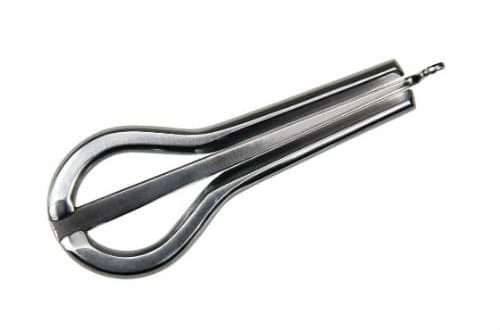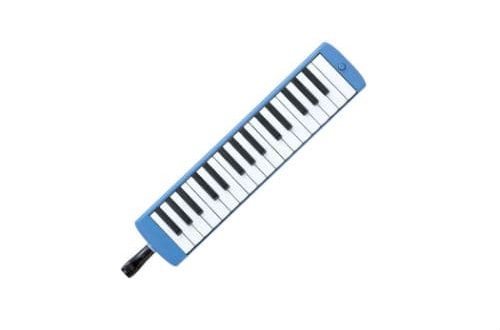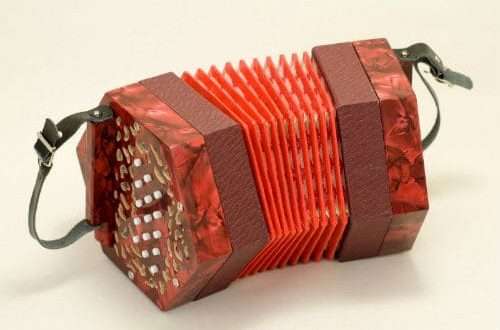
Accordion: what is it, history, composition, how it looks and sounds
Contents
The accordion is a fairly popular, widespread musical instrument. Any conservatory has classes that teach how to play it. The accordion is multifaceted, has a wide range of sounds. Works ranging from classical to modern sound organically in the performance of this advanced harmonica.
What is an accordion
The accordion is a musical instrument considered to be a type of hand harmonica. Equipped with a piano-like keyboard. It is similar to an accordion: depending on the model, it has 5-6 rows of buttons that produce sounds of basses and chords, or separate notes.
The tool has two rows of buttons located on the left, on the right. The right one is for playing the melody, the left one is for the accompaniment.

The difference from the button accordion lies in the drill tongues. In the button accordion, the reeds are tuned in unison, while in the accordion they somewhat do not match in tonality, giving the sound a special charm.
The sound of the accordion is powerful, rich, multifaceted. Due to this, the instrument can be both solo and accompanying.
accordion device
The internal structure of the accordion is a whole system of interconnected mechanisms:
- tongue;
- opening valve;
- voice bar;
- input chord chamber;
- bass input chamber;
- entrance chambers of melodies;
- fur;
- neck;
- melody keys;
- accompaniment keyboard buttons;
- melody and accompaniment register switches.
Two keyboards, according to the diagram, are connected by fur, which helps to pump air into the pneumatic keyboard mechanism. When you press the keys, air flows through the tongues penetrate inside until it stops. By simply acting on the desired group of keys, the player opens the air valve, the air from the bellows enters a certain sound chamber, exits through the voice bar, making the required sound.
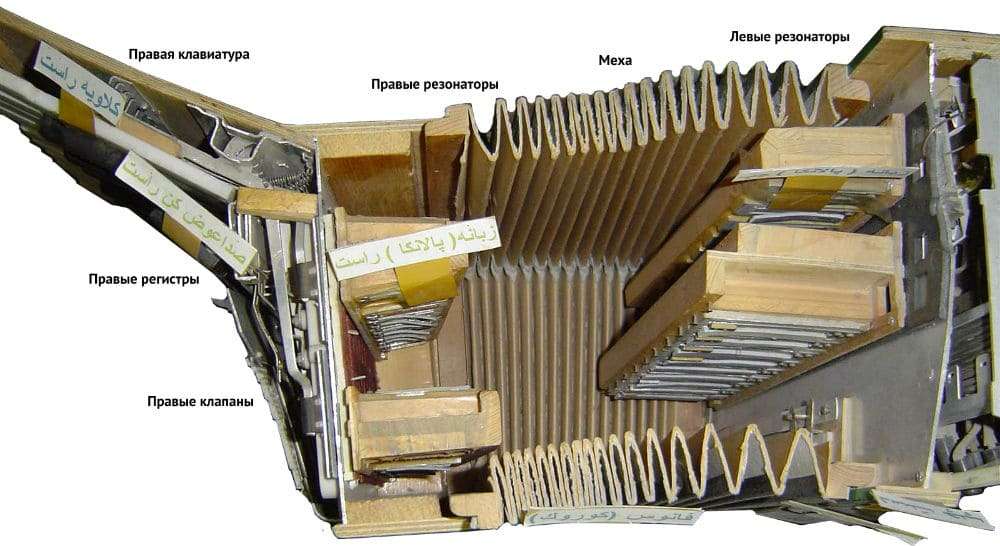
History of the accordion
The history of the accordion goes back to the deep past: the origin is connected with China, where the mouth harmonica was first invented. When active international trade began, the instrument came to Europe, after which its cardinal transformation began.
Invented a model similar to the modern version, the organ master Cyril Damian, a native of Vienna. The event took place in 1829: the craftsman presented the invention to the world, patented it, and came up with the original name – “accordeon”.
The history of the musical instrument began on May 23, 1829, when K. Damian patented the invention. Today May 23rd is World Accordion Day.
From Vienna, the musical device migrated to Italy: here, for the first time, production was launched on an industrial scale.
In Russia, the musical device first appeared late, in the 40s of the XIX century. Initially, the curiosity was bought abroad; wealthy people (merchants, aristocrats, privileged strata of the population) could afford such a luxury. Gradually, with the help of serfs, the accordion came to villages, villages, soon turning into almost a Russian folk instrument.
Today, this instrument is in demand in concert activities: it is able to reproduce a unique sound range, imitate the sounds of other musical instruments. Virtuoso, professional performers are able to beat almost any composition, different in genre, style, direction.
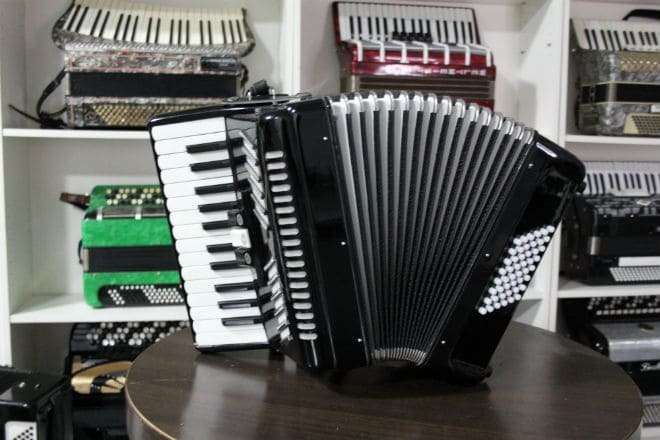
Types of accordions
The classification is made according to several important features:
1. Keyboard type:
- Keyboards (the keyboard is arranged like a piano),
- Push-button (the keyboard is represented by several rows of buttons).
2. Accompaniment system in the left hand:
- Ready (composition of the accompaniment: basses, ready chords),
- Ready-selective (the instrument is equipped with two systems (ready, elective) that can change using the register).
3. By size (there are different sizes, from small, student models, to concert ones. Small accordions are called amateur accordions):
- 1/2 – used to teach the Play to children aged 5-9 years. The model is diatonic – the keyboard is push-button, the scale is limited. Minimum weight, range approximately two octaves.
- 3/4 – an instrument created for students of music schools, amateur playing. It has a range of 2 octaves. This type of accordion, as a rule, is three-part, with ready-made accompaniment. Suitable for simple repertoire.
- 7/8 is a model designed for adult musicians. Scope of application – amateur music playing. The range is three octaves.
- 4/4 is a professional, concert instrument. The range is 3,5 octaves. Maybe three, four, five voices.
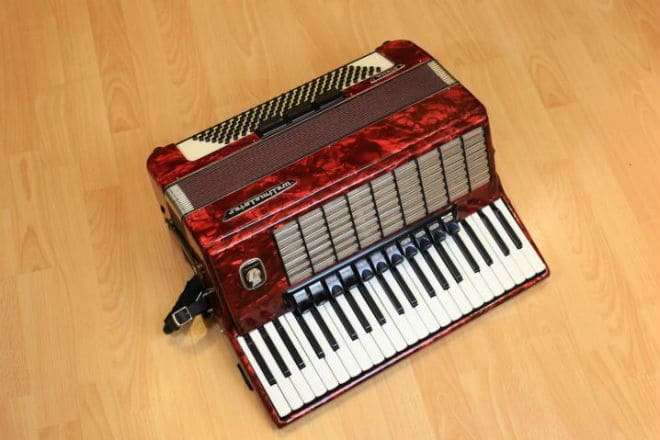
Separately, it is worth mentioning the digital models produced since 2010. The country of origin is Italy, but the release is made by the Roland trademark (Japan). The Japanese bought the old Italian company Dallape, the oldest manufacturer of accordions. From that moment, the business began to develop in a different direction, the first digital accordion saw the light.
The main advantages of a digital tool:
- ease,
- the ability to connect to a computer, headphones, speaker,
- insensitivity to external conditions (temperature, humidity),
- long service life,
- built-in metronome
- change settings, sound timbre with one keystroke.
The creation of a digital model has become a new stage in the modernization of the instrument, which has made it possible to improve its structure. It is likely that this is far from the end, and the device will continue to change, become more complex, and develop.
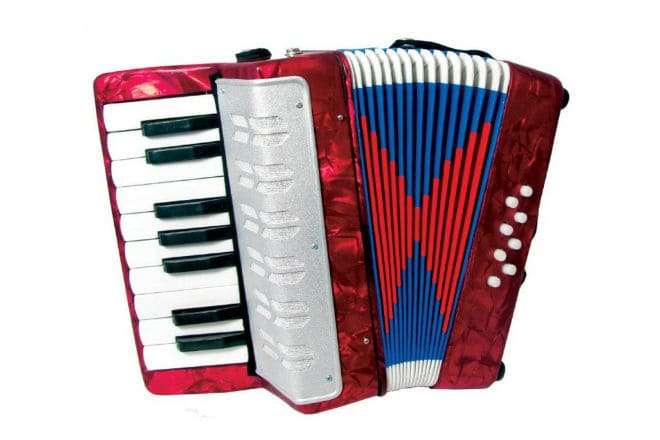
How to choose an accordion
Choosing a musical instrument is a serious matter. The slightest defects will definitely negatively affect the sound. Experts advise to pay attention to the following fundamental points:
- Appearance. The body, belts, furs must be without damage (dents, scratches, cracks, tears, holes). Even the slightest deformation is unacceptable.
- Sound quality. It is easy to check this parameter: you need to part, then bring the fur together without touching the keys. It will immediately become clear whether there are holes on the fur that have gone unnoticed during visual inspection. If the air escapes too quickly, the bellows are unusable.
- The quality of buttons and keys. Buttons, keys, should not sink in, be pressed too tightly, be located at different heights.
- Tool in action. The simplest melody played on the instrument completes the pre-sale inspection. Buttons should not creak, wheeze, make other extraneous sounds. Registers are ideally easy to press, then quickly return to their original position.
- The size. If a child needs a thing, size matters: convenience during the Play will be provided by an object that does not reach the chin a little (when kneeling a young musician).

Interesting Facts
Music lovers will be interested in curious facts related to the modernized harmonica:
- A standard instrument weighs an average of 8-10 kg, a concert instrument is heavier – 15 kg.
- “Accordeon” is a French word meaning “hand harmonica”.
- The American continent got acquainted with the first copies in the XNUMXth century, and they were called “pianos on straps”.
- The period of the highest popularity of the instrument fell on the first half of the XNUMXth century.
- The State of California erected a monument to the accordion.
- The price of professional models is tens of thousands of dollars. The most expensive accordion brand in the world is Hohner Gola – $30.
- The best tool manufacturing plants are located in Europe (Italy, Germany, Russia).
- Russian enterprises engaged in the production of professional models – “AKKO”, “Russian accordion”.
- In the homeland of the instrument, in China, it is called “Sun-Fin-Chin”. The ancient prototype is considered to be the “shen”, a harmonica that adorns the United States Museum.
The accordion is a relatively young musical instrument, the formation of which cannot be considered fully completed. Models are regularly upgraded, improved, delighting musicians and listeners. A powerful, multi-voiced sound that can imitate any sounds is the main reason for its worldwide popularity.



